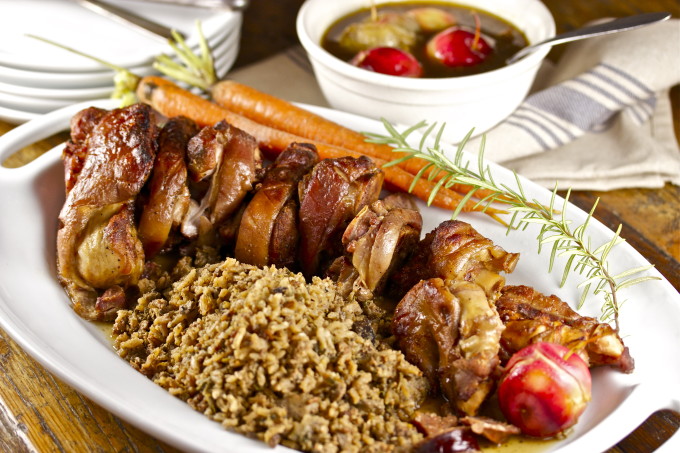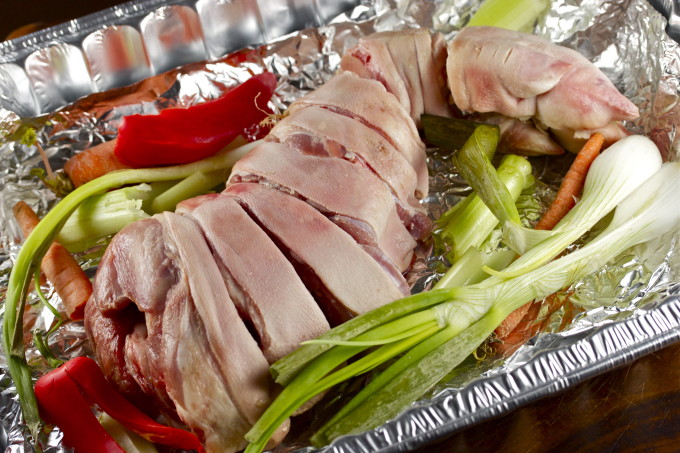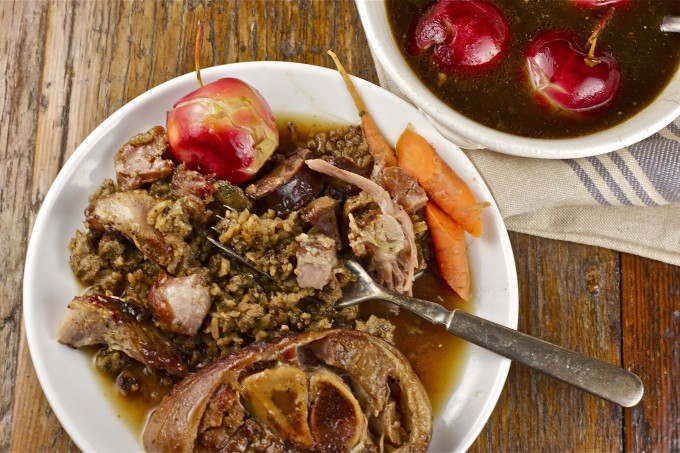Let me start by saying this: a kind of instinctive, carnivorous joy comes from digging into a braised whole pig’s leg. This isn’t the tidy, delicate dish you’d find at a fine-dining restaurant. No, this is rough, meaty, with the soul of something primeval—steeped in history and soaked with the kind of flavors that make your mouth water in ways that can’t be replicated by anything else. And when you throw crabapples into the mix, you get something else entirely. It’s a marriage of sweet, tart, and savory so complex it makes you holler for more.

Pork leg slowly braised served with Cajun rice dressing. (All photos credit: George Graham)
Over the years, I’ve come to embrace the slow food movement in America, South Louisiana, too, that is reconnecting families and farmers in a relationship that brings meaning to the dinner table. My Saturday morning jaunts to the Lafayette Farmer’s and Artisan Market at Moncus Park in Lafayette is a case in point. Sustainable, locally sourced meats, fruits and vegetables are fast becoming the heart of my grocery shopping rather than the exception.
The whole pig’s leg recipe I share with you today is a celebration of that connection, and I hope you will embrace the dish’s clarity of purpose and simplicity. Provoking family discussion about where our food comes from is the only way to sustain our culinary heritage. That kitchen-table conversation is what has sustained the Cajun and Creole foodways that I write about. Slow braising a leg of pork in a sweetened apple-infused bath is a classic treatment that deserves to be brought back to our tables.

A well-butchered leg of pork is a beautiful thing.
The pig’s leg, whether the front or back, has long been the workhorse of the butcher’s block. It’s tough, sinewy, and demands patience. But if you treat it right, braise it low and slow in a decadent, aromatic bath of stock, cider, and herbs, you’ll get meat so tender it practically falls apart at the touch of a fork. The skin crisps up into something resembling a crunchy, savory candy, while the fat transforms into something unrecognizably soft and luscious. Every bite is a reminder that when treated right, fat is not the enemy—it’s the secret weapon. Now, the real trick with this dish isn’t just about braising the leg until fork tender. No, you’ve got to throw in a little something unexpected. Enter the crabapples.
I found a bin full of crabapples at Fresh Pickin’s, my local green market, and the idea for this recipe took shape. Crabapples eaten raw are a bit on the sour side, but when cooked down in a cider-based braise their tartness balances it all out in a perfect combination. Tart flavors work as a perfect foil to the richness of the pork, cutting through the heaviness with just the right amount of acid and sweetness.
The marriage of flavors—pork and apple—is one of those simple yet timeless combinations. And while this dish is indulgent, it’s still rooted in the simple pleasures of life—good ingredients, slow cooking, and the joy of sharing a meal that makes you feel like you’ve earned it.

The crabapple sauce is the perfect balance to the richness of the meat.
- 2 quarts water
- 2 cups apple cider
- ¼ cup sugar
- ¼ cup salt
- 1 whole leg of pork, butchered, cleaned and cut into pieces with the pig's foot
- 1 onion, quartered
- 2 stalks celery, cut into chunks
- 1 bell pepper, cut into chunks
- 2 carrots, cut into chunks
- 1 dozen crabapples or tart apples
- 1 (12-ounce) jar apple sauce
- 2 cups apple cider
- 2 tablespoons apple cider vinegar
- 4 sprigs fresh rosemary
- Kosher salt and freshly ground black pepper
- 2 cups pork stock or chicken stock
- 2 tablespoons cornstarch
- 2 tablespoons water
- In a large lidded container, make a brine by adding the water, cider, sugar, and salt. Stir to combine. Add the pork and close the container. Refrigerate overnight.
- Preheat the oven to 350ºF.
- Remove the pork leg pieces from the brine and place in a foil-lined baking pan. Add the onion, celery, bell pepper, and carrots along with half the crabapples. Pour the jar of apple sauce into the pan and distribute evenly. Add the cider and vinegar along with the fresh rosemary. Season lightly with salt and pepper. Cover the pan with foil.
- Place the pan in the oven and cook for 90 minutes. Uncover the pan and strain the liquid into a pot along with all the vegetables and the pig’s foot. Place the remaining pork back into the oven to cook uncovered for another 30 minutes. Remove from the oven and cover with foil to keep warm.
- Over medium-high heat, bring the liquid and the contents in the pot to a boil and add the pork stock. Reduce the heat to a simmer and let cook for 15 minutes. Using a slotted spoon remove all of the vegetables and pig’s foot from the liquid. Add the remaining 6 crabapples to the pot. Bring to a simmer and let cook for another 20 minutes as the liquid slowly reduces and the crabapples cook down.
- To thicken the sauce, make a slurry by adding the cornstarch to a small bowl and adding the cold water. Stir to combine and add half of it to the simmering pot of stock. Bring the pot to a boil and watch as it thickens to a desired thickness. If the sauce is not thick enough, add more cornstarch slurry until you can coat the back of a spoon. Sample the sauce and season with salt and pepper to your taste.
- For serving, remove the pork pieces and arrange on a platter. Spoon the sauce over the pork and place the cooked crabapples alongside on the platter. Serve with sautéed carrots and Cajun rice dressing along with a pitcher of sweet tea.
YOUR SEAT AT THE TABLE: If you like this story and recipe then accept my personal invitation to subscribe by entering your email at the bottom or top right of this page. It’s quick and painless. You will receive an email alert and be the first to see when new stories and recipes are added. Thanks, George.
Thank you for the cracklin adventure! I haven’t had any since I moved from Louisiana to Minnesota over 2 years ago. I’m going through withdrawal!
You have a delicious blog!
Fascinating.
You’re taking me out of my familiarity zone again, as you regularly do. I’ve never met a pig’s leg before. Does the leg that you pictured include the butt? How much does it typically weigh? Sure looks like it feeds more than two.
Thanks, and I’ll give this a try if I can source the pork. Of course, I will NOT show my wife the trotter, as she would say “Ewww”, and not try the dish. City girl.
Joe- The leg portion comes in varying sizes, but I see them around 3 pounds. There is lots of bone and fat, so that will certainly feed 2 to 4. All the best.
Exactly the information that I needed.
Thanks.